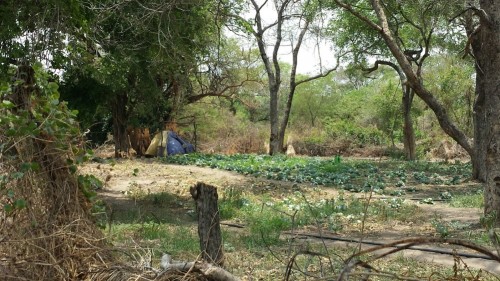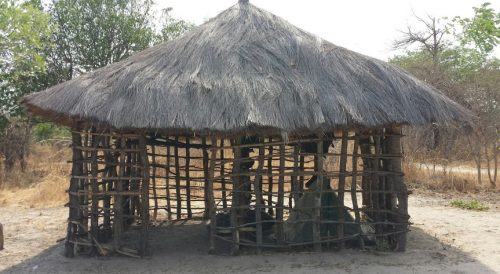
Sarah Eccleston – Cisco UK&I’s Director of EN and the Internet of Things – is in Zambia spending a month living in an elephant orphanage, where she hopes to connect elephants to the internet. Follow Sarah to Africa and back on this blog to find out why, how and whether it works. You can also read her opening blog here.
Meet the Orphans:
Each blog post, I will share pictures of a couple of the orphans and their stories here…..
Having been on a 5-star safari in South Africa, I knew exactly what to expect on arrival in Zambia. Unfortunately, most of Africa is nothing like a 5-star safari, as I found out this week when I showered with three frogs.

Sarah’s accommodation
But it is completely worth it to meet the orphans living here, including these guys:-

The third of these orphans is just two and a half years old. He was rescued after poachers shot his Mother for ivory and he was named Musalole after the scout who was shot dead trying to save his Mother from the poachers. Fortunately, the event was witnessed and the orphan was reported to GRI who rescued him and brought him to the orphanage for care.

This orphan is a little older and was brought into GRI after poachers slashed his spine, causing nerve damage and thus an immobile rear, right ankle (you can also see them lumps on his spine where they damaged him). The GRI team put a cast on his ankle, except for the middle of the day when he loves to play in the mud bath, so they take it off for him to play. Because it is then difficult for him to get out of the mud pool without the use of his rear ankle to push him up, the other orphans help him by getting behind him and giving him a push. And that just about sums up what lovely creatures elephants really are.
Technology Assessment: Human-Elephant Conflict
For this feasibility study, I wanted to see all parts of the conservation process, so this week I accompanied the team visiting the surrounding farmland where the human-elephant conflict arises, and my first shock was the African definition of a “farm”.
If when I say “farm” you are imagining hundreds of hectares of land, with a nice big farmhouse, a log fire, and an Aga ticking away in the kitchen, read on. Because no, here in Africa, a farm is this:-

An African farm… which needs to be protected FROM the elephants.
That tent you can see in the corner is where the farmer, his wife and his children live. That one small field is where he grows his crops once a year to sell which, apart from also growing maize, is the family’s main source of income for the whole year.
So when the elephants stroll in and eat everything in sight, you can see why that’s a problem.
(To be accurate, the elephant doesn’t eat everything – they eat everything except the spring onions. Nothing says “We were visited by elephants in the night” like a bare, upturned field of soil with one little square of thriving spring onions in the middle of it).
An average bull elephant eats 500kg of food a day, so munches for 16 hours daily… so we can’t blame the elephants. But this needs to be addressed by the conservation team, because it breeds contempt for the elephants amongst the human population with whom they share the land.
The Challenges:
- The small farm holding is surrounded by a man-made fence of sticks and thornbushes, which keep out the thieves, but are no obstacle to an elephant. I suggested building a brick wall instead, but that isn’t commercially viable for the farmer because the farm is on floodplains and every rainy season the brick wall would be under water and would need to be re-built every year.
- Moving the farms off the floodplains isn’t an option, because then the soil isn’t fertile.
- Planting tasty vegetation to attract the elephants en route to the farm landmight stop them ever needing to track to the farms. But that is interfering with the ecosystem.
- Flapping pieces of silver paper, which make a noise and glint in the moonlight have been installed on string around the farms. These are having some success but a strong wind can tear them away.
- A small gadget which flashes an intermittent red light during darkness has been installed on posts around the farms, and some success has been seen. However, some farms with them have still signs of elephant destruction, plus these are easily stolen by local Africans (though no-one can imagine what the thief then does with them?!). One of our jobs this week was visit every farm to count how many have been stolen.
- Electric fencing around the farm land would be more of a deterrent, but the solar panel and battery for the fencing is also very likely to get stolen.
- What’s worse, is if the wire fence then gets stolen, wildlife poachers can make snares out of it, so we can create more problems than we solve. Polywire is a better alternative as it is so thin, they can’t make a snare out of it.
Technology that would really help:
- Standard Internet access in this part of the world is not an option. It’s very, very remote (we drove for 9 hours from Zambia’s capital City, Lusaka, to get here).
- If the devices placed on the posts could instead be tripped when the elephants arrive, which triggers a bright, flashing light, that would be a better deterrent.
- Even better, if it could trigger the sound of a gunshot, the elephants would flee from the farm, and because elephants have the memory of, well, an elephant, they would soon learn not to return there.
- But… the team here have learned that elephants can only be “bluffed” for a short period of time, until they figure out there is no consequence. So, ideally something that triggers a consequence is better (which is why electric fencing is effective).
- The National Park is 22,000 square kilometres, and around the park is a “buffer zone” of game-managed territory, between the park and the farmland. On that game territory, armed scouts live and patrol. If some technology could trip and text/alert the scout when an elephant approaches the farm areas, the scout could rapidly respond.

A poacher’s tent
- There is a 40km stretch along the buffer zone where the farms are prevalent. If a row of electric fencing could be placed along there, with a house and scout every 5km, the solar panel and battery could be housed with the scout… that would deter the elephants from crossing the wire. It also gives good poaching protection deterring the poachers from crossing into the game-managed land and park (though they could still do so along other borders of the park).
- Of course, the Cisco Connected Agriculture solution, with sensors in the soil which then alert officials when elephants are approaching the farm land would be a big help. But that relies on a lot more GSM or internet connectivity than is currently available in such a remote area, so on returning to the UK, a viable means of connecting them needs to be explored.
Next week: investigating how technology can help the day to day operations at the Boma (where the orphans live) and I accompany the research scientists on a transect to identify the herds in the field. Plus, the Cisco 819 router gets it’s day as we try to connect elephants to the internet.
8 Comments
I love your blog. The issues you raise are so important
Hi Sarah,
I don’t have your email address – it didn’t show up on your last post. Could you send it to me at michele.brailsford@inmarsat.com
Many thanks,
Michele
Hi Michele,
Really sorry but no email has come through from you… could you please let me know the address you send your personal email address to? I am here for another week so I have time to answer and write (new blog post appearing today or tomorrow).
Many thanks
Sarah
Hi Sarah,
Thanks so much for replying and sorry that no-one got back to you earlier.
That’s brilliant. I’ll look forward to reading your next blog!
I’ve left my personal email address as I didn’t receive your email to the Inmarsat address – it may have been blocked.
Good luck with the sensors!
Michele
Hi Sarah,
I work for Inmarsat as a writer and we’d love to post a story about your idea about connecting elephants to the internet. I understand that you’re using a BGAN terminal to post blogs. Have you got access to email so I could send you some questions?
Many thanks,
Michele
Hi michele,
It is really nice to hear from you.
My blog post next week is about the connection of an elephant sensor to the internet and the inmarsat BGAN features in it… in fact, there will be a picture of me setting up the BGAN next to a mud hut here in Africa.
Before my trip, I had written to Inmarsat to ask whether they had a BGAN to send (and also a newer smaller version being Beta trialled) and I also asked if they wanted to write about it as it’s a Cisco-Inmarsat story. I got no response at the time, but yes of course I would still be very happy for you to write about this. Doing so after next week’s post would be ideal for you I guess, as it’s very Inmarsat-relevant.
Please let me know if you get the email address with this reply?
If I may ask, Please don’t send any attachments to your email as i only have 100Mb on the BGAN to last me for the whole trip.
Thank you again, really good to hear from you, and keen to can help any way I can,
Sarah
Being of a different generation, the thought of connecting animals to the internet seemed a tad bizarre to me. However, after reading this entry…. ‘I get it’.
Initially it was about the slaughtered elephants and their orphans but you have delivered to me a much deeper understanding of the difficulties that humans and animals encounter when trying to live together. You have explained the traumas of life from both sides.
If there was ever a need to connect animals to the internet it is here. I am proud of you for thinking of it and for using your knowledge of technology to try and do something to help these people and these elephants.
I hope it can be done. But as I have said before, if anyone can do it ……… I won’t repeat myself.
Great people photos.
Love Mom x
I wish …more challenging of scientist’s